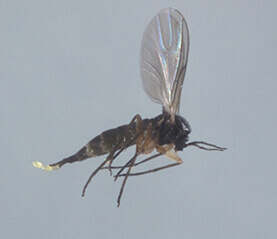
Gnat Life Cycle
Egg
Female fungus gnats lay their eggs a few inches below the ground in warm, moist soil. The pests favor high temperatures, making greenhouses, garden centers, and plants in heated homes popular sites for infestation. Gnat eggs typically hatch within six days.
The average adult gnat lifespan is one week, and they can lay up to two hundred eggs in that time. It only takes the pests about 28 days at most to complete their whole life cycle. So if you’re wondering how fast do gnats reproduce or how often do gnats reproduce, the short answer is: A LOT.
Larva
Gnat larvae have white or clear bodies, no legs, and shiny black heads. After hatching, they feed on plant roots and decaying matter. If a gnat issue is severe, you might notice larvae’s slime trails on leaves or around planters. The larval stage lasts about two weeks, though warm temperatures increase the insect’s rate of growth.
Pupa
Gnats start to pupate at the end of their larval stage. This process takes three to six days and occurs primarily in the soil. This is usually the shortest phase in the lifespan of a gnat. Once pupation occurs, the pests emerge as winged adults and begin reproducing.
Adult
Adult gnats do not bite and generally won’t harm your plants. However, despite the short life expectancy of gnats, these pests can create quite a nuisance in large numbers. Along with homes and greenhouses, they can disturb guests at hotels and outdoor restaurants. Florists are also at risk for gnat infestations.
Addressing a Gnat Problem
Since a gnat’s lifespan is so short, generations overlap and mature in the same location. A single potted plant in your home or office could contain pests in all four phases of the gnat life cycle at the same time. If you see gnats flying around your flower pots or foliage, contact Western Pest Services to prevent a potential issue.